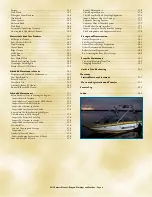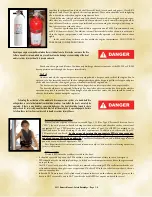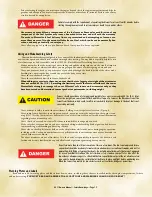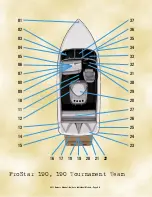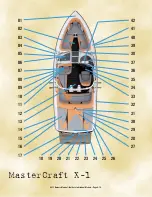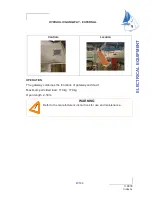
•
Put on PFDs.
•
Turn on running lights.
•
Head for the nearest shore that is safe to approach, if possible.
•
Head bow of boat into waves at about a 45-degree angle.
•
Keep bilges free of water.
•
Seat passengers on bottom of the boat, near the centerline.
•
If the engine fails, tie a sea anchor on a line from the boat to keep the boat headed into the waves. A
bucket will work as a sea anchor in an emergency.
•
Anchor the boat, if necessary.
Staying Afloat
It is commonly believed that someone dressed in heavy cloth-
ing or waders will experience considerably more difficulty staying
afloat if they fall overboard. This is not true. Air trapped in cloth-
ing provides flotation and bending the knees will trap air in wad-
ers. To stay afloat:
• Remain calm. Do not thrash about or try to remove clothing
or footwear. This leads to exhaustion and increases the loss of
air that may keep you afloat.
• Keep your PFD on.
• Keep your knees bent.
• Float on your back and paddle slowly to safety.
Cold Water Survival
Sudden immersion in cold water can induce rapid, uncontrolled
breathing, cardiac arrest and other physical body conditions, which can lead to drowning. Always wearing a
PFD will help survival in rapid immersion situations.
In other situations when entry into cold water is necessary:
• Wear a PFD.
• Button all clothing.
• Cover your head if possible and enter the water slowly.
• Keep your head out of the water if at all possible.
• Assume the Heat Escape Lessening Posture (HELP) position as taught within a Coast Guard-taught safe-
ty course.
Hypothermia
Immersion in water speeds the loss of body heat and can lead to hypothermia. This is the abnormal low-
ering of internal body temperature. If a boat capsizes it will likely float on or just below the surface.
To reduce the effects of hypothermia, get in or on the boat. Try to get as much of your body out of the
water as possible. If you can’t get in the boat, a PFD will enable you to keep your head out of the water. This
is very important because about 50 percent of body heat loss is from the head.
It may be possible to revive a drowning victim who has been under water for some time and shows no
sign of life. Cases document instances where victims have been resuscitated after extended periods. Start
CPR immediately and get the victim to a hospital as quickly as possible.
Immersion Suits
Immersion suits will delay the effects of hypothermia in cold water and are available through many re-
tailers who specialize in sales of marine products. The suits should be stored and maintained according to the
manufacturer’s instructions.
Inflatable Life Rafts
An inflatable life raft can provide a survival platform for an extended period of time. Be sure the
life raft is large enough for everyone on board when the boat operates off-shore. It should have the ap-
propriate emergency equipment pack and should be professionally serviced periodically, according to the
manufacturer’s instructions. Coast Guard-approved life rafts must meet a number of stringent material
and performance standards.
2011 Owners Manual...Safety Knowledge...Page 1-9
Содержание prostar 190 2011
Страница 26: ...Guide to Individual Models 2011 Owners Manual Guide to Individual Models Page 4 1...
Страница 81: ......
Страница 93: ......
Страница 105: ......






